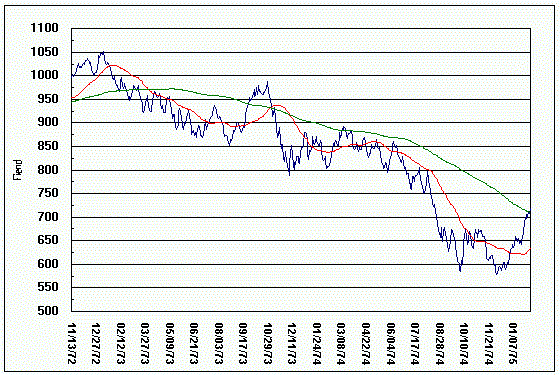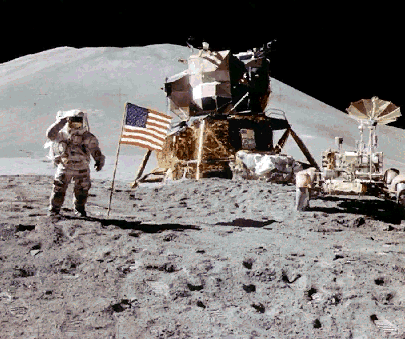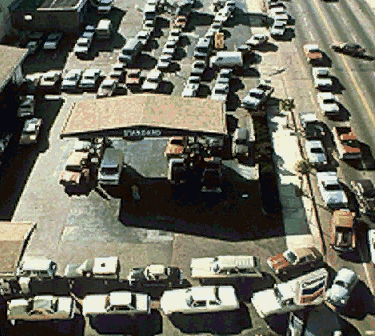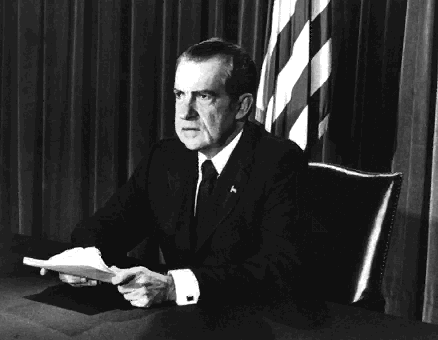
THE TOP:
 This was the era of the "two tier" market when large-cap "nifty fifty"
or "one decision stocks" powered the Dow ahead as other smaller issues
languished. Incumbent Richard Nixon defeated George McGovern in landslide
victory in November of 1972 and to celebrate, the Dow closed above the
mythical 1000 level for the first time about one week later. The Dow first
challenged the 1000 level back in 1966 and its was a momentous event for
it to finally exceed it. Many major magazines including Time, Business
Week, and Newsweek had feature stories covering the Dow's amazing run and
the lack of participation by smaller non-Dow stocks was not perceived to
be a serious problem. The Dow suffered a brief 4% correction near the end
of 1972 but it successfully tested the key 1000 level which was very encouraging
to the Bulls. The Dow proceeded to shoot up another 5% in less than three
weeks and its final closing peak of 1051 would not be beaten until November
of 1982. From mid October to its January peak, the Dow jumped 13%. Near
the Dow's January peak, Barron's ran an article titled, "Not a Bear Among
Them" to describe the bullish consensus of institutional investors.
This was the era of the "two tier" market when large-cap "nifty fifty"
or "one decision stocks" powered the Dow ahead as other smaller issues
languished. Incumbent Richard Nixon defeated George McGovern in landslide
victory in November of 1972 and to celebrate, the Dow closed above the
mythical 1000 level for the first time about one week later. The Dow first
challenged the 1000 level back in 1966 and its was a momentous event for
it to finally exceed it. Many major magazines including Time, Business
Week, and Newsweek had feature stories covering the Dow's amazing run and
the lack of participation by smaller non-Dow stocks was not perceived to
be a serious problem. The Dow suffered a brief 4% correction near the end
of 1972 but it successfully tested the key 1000 level which was very encouraging
to the Bulls. The Dow proceeded to shoot up another 5% in less than three
weeks and its final closing peak of 1051 would not be beaten until November
of 1982. From mid October to its January peak, the Dow jumped 13%. Near
the Dow's January peak, Barron's ran an article titled, "Not a Bear Among
Them" to describe the bullish consensus of institutional investors.
THE BEAR:
 The
Dow's initial move down in January of 1973 was very sharp and within a
month, it was off 100 points or almost 10%. As it is apparent from the
chart above, the Dow's slide was extremely volatile with big losing streaks
often followed by sharp rallies. In the meantime, the Watergate scandal
was beginning to grow as top Nixon aides resigned at the end of April amid
charges of obstruction of justice. The Dow's fall continued until late
August when it finally bottomed at 857 to complete a seven month loss of
almost 200 points (over 18%). From this point, the Dow surged ahead so
rapidly that the Bulls were likely lulled into believing that a new leg
up was occurring. Amid October's Yom Kippur War, Vice President Spiro Agnew's
forced resignation, and an Arab oil embargo, the Dow closed at 987 near
the end of that month for a gain of 15% off of its summer lows. The huge,
two month rally left the Dow just 6% below its all time high set back in
January but the NYSE's advance/decline line was still in shambles. In addition,
higher interest rates were taking their toll on the economy which officially
entered a recession in November. The divergence between the large-cap stocks
and smaller-cap stocks was resolved over the next five weeks as the "nifty
fifty" experienced a brutal reckoning and the Dow plunged 200 points or
over 20%. The Dow bottomed at 788 in early December of 1973. After jumping
back above 850 in early 1974, the Dow remained in a trading range as impeachment
hearings against Nixon began. Nixon finally resigned in early August but
this did not bring any relief to the Dow which continued to trade near
the 800 level.
The
Dow's initial move down in January of 1973 was very sharp and within a
month, it was off 100 points or almost 10%. As it is apparent from the
chart above, the Dow's slide was extremely volatile with big losing streaks
often followed by sharp rallies. In the meantime, the Watergate scandal
was beginning to grow as top Nixon aides resigned at the end of April amid
charges of obstruction of justice. The Dow's fall continued until late
August when it finally bottomed at 857 to complete a seven month loss of
almost 200 points (over 18%). From this point, the Dow surged ahead so
rapidly that the Bulls were likely lulled into believing that a new leg
up was occurring. Amid October's Yom Kippur War, Vice President Spiro Agnew's
forced resignation, and an Arab oil embargo, the Dow closed at 987 near
the end of that month for a gain of 15% off of its summer lows. The huge,
two month rally left the Dow just 6% below its all time high set back in
January but the NYSE's advance/decline line was still in shambles. In addition,
higher interest rates were taking their toll on the economy which officially
entered a recession in November. The divergence between the large-cap stocks
and smaller-cap stocks was resolved over the next five weeks as the "nifty
fifty" experienced a brutal reckoning and the Dow plunged 200 points or
over 20%. The Dow bottomed at 788 in early December of 1973. After jumping
back above 850 in early 1974, the Dow remained in a trading range as impeachment
hearings against Nixon began. Nixon finally resigned in early August but
this did not bring any relief to the Dow which continued to trade near
the 800 level.
THE BOTTOM:
 After
Nixon's resignation in early August of 1974, the Dow began another terrible
decline which slaughtered the remaining Bulls. Over the next two months
the Dow would drop from 797 to 584 in early October for a loss of 27%.
During the plunge, the Dow was hit with a losing streak of 11 straight
sessions for a 13% total loss. After hitting bottom, the Dow shot up 16%
to 675 in early November, but those gains were quickly lost as the Bulls
finally capitulated in despair. The Dow fell to a new low of 577 by early
December which was to mark its final bottom in the 1966-1982 secular bear
market. The Dow's close of 577 (45% off of its peak) was its lowest level
since October of 1962 and sentiment at this bottom was absolutely grim.
The same major publications that cheered the Dow at 1000 two years ago
were now overwhelmingly pessimistic. Articles such as "Dow below 400?"
from Forbes and "Is there no bottom?" from Newsweek were typical of the
period. As the Dow began to rally off of its second drop below 600, it
became apparent that the selling over the past couple of years had finally
played itself out. The Dow was trading at 25% below its 200 DMA and the
subsequent rally was so strong that it managed to get back to its 200 DMA
in just two months with a close of 717 by February of 1975. The recession
which began in late 1973 officially ended in March and the Fed was now
easing interest rates. By May, the Dow was trading at 855 for an astounding
gain of 48% off of its lows from just five months ago.
After
Nixon's resignation in early August of 1974, the Dow began another terrible
decline which slaughtered the remaining Bulls. Over the next two months
the Dow would drop from 797 to 584 in early October for a loss of 27%.
During the plunge, the Dow was hit with a losing streak of 11 straight
sessions for a 13% total loss. After hitting bottom, the Dow shot up 16%
to 675 in early November, but those gains were quickly lost as the Bulls
finally capitulated in despair. The Dow fell to a new low of 577 by early
December which was to mark its final bottom in the 1966-1982 secular bear
market. The Dow's close of 577 (45% off of its peak) was its lowest level
since October of 1962 and sentiment at this bottom was absolutely grim.
The same major publications that cheered the Dow at 1000 two years ago
were now overwhelmingly pessimistic. Articles such as "Dow below 400?"
from Forbes and "Is there no bottom?" from Newsweek were typical of the
period. As the Dow began to rally off of its second drop below 600, it
became apparent that the selling over the past couple of years had finally
played itself out. The Dow was trading at 25% below its 200 DMA and the
subsequent rally was so strong that it managed to get back to its 200 DMA
in just two months with a close of 717 by February of 1975. The recession
which began in late 1973 officially ended in March and the Fed was now
easing interest rates. By May, the Dow was trading at 855 for an astounding
gain of 48% off of its lows from just five months ago.